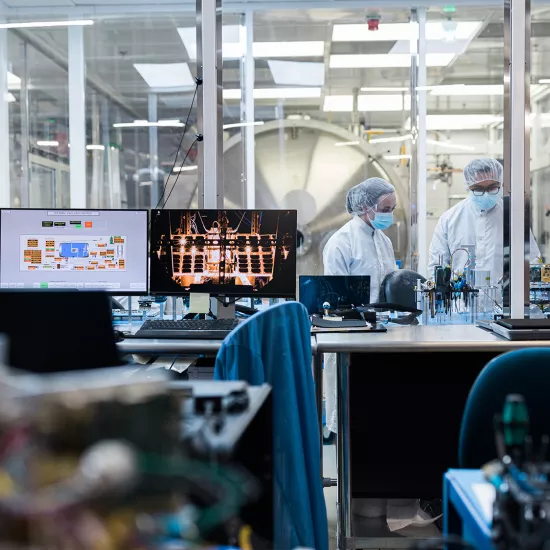Glenn Morris

Curiosity drives Professor Glen Morris down to South American rainforests, over to Lake Superior, and through a Davis Building hallway to his soundproof lab where he disentangles the beautiful sound signals of insects. Here, surrounded by trays of well-preserved cricket-like creatures, thick cozy walls, and a picture of a canoe, the Professor Emeritus of Zoology explores the secret world of the singing katydid.

Morris has studied the katydid, a spindly family of insect, since Erindale’s first class in 1967 when the campus consisted of one half of the North Building, less than 500 students, and a staff of 50. Fresh from Cornell with his PhD, Morris taught as the resident zoologist in Room 237. “Yeah, I’m an antique,” jokes Morris.
Yet Morris continues to offer a fiery contribution to both entomology, which is the study of insects, and research into sound generation. Morris unravels how the incredibly small and lean katydid can produce an intense sensory sound. Communicating a sound is integral to how katydids claim territory and find love. A male will belt out a serenade so that a female might find him. His song – stringy and high-pitched – varies between the 6400 different species of katydid. And while humans can hear the calls quite clearly, some katydids produce sounds beyond our range of hearing.
In 2006, Morris discovered the highest-pitched singing insect in the world. Found on the island of Gorgona just off the Columbian coast, this katydid snaps the structures of its wings like a drumbeat 130,000 times a second, which releases an incredibly high-pitched sound. Morris explains that his fascination for the insects arises from the discovery that the katydid uses accelerated elasticity to produce the noise rather than simply muscle.
Morris collects, records, and analyzes katydids from all over North and South America, travelling to such places as Ecuador, New Guinea, Wyoming, and Costa Rica. But while his research requires him to observe the insects in the field or in labs, Morris also recommends the katydid as an ideal family pet: “You don’t have to take them for a walk. Just leave them in a cage, feed them a little bit of apple, and they’ll sing for you,” says Morris. In fact, he says he can even converse with them, and his imitation of a call elicits a reply from his confused katydids.
These conversations often prompt more questions about katydid communication. Currently, one of Morris’ burning questions revolves around the bog katydid’s two-part song. He would like to know how and why they use the two different song components. For now, it seems the male katydid has adapted to continue singing one part when in the company of another male.
And while the katydid remains a small and often camouflaged creature, understanding how and why it communicates awards us the precious gift of insight.
“Yes, their communication involves a less complicated information transfer than our own,” says Morris. “But that’s not to say if you want to understand communication, you can’t learn something from katydids.”
Morris believes that the information he collects may help engineers develop different approaches to hearing aids. His research provides valuable insight into how tiny generators, like the katydid he found in Columbia, can produce powerful sounds, and will help with devising an efficient hearing device. Furthermore, Morris’ research contributes to a demystification of biological phenomena. “If nobody studied these things,” Morris explains, “we’d be in a lot worse mess.”
While Morris has not witnessed significant changes to research funding since being awarded his first research grant in the late 1960s, the process of receiving grants has gotten more complicated. “Now it’s more involved than it was in 1967, and this is understandable,” says Morris. “People try to ensure that a taxpayer’s money is properly dispensed. A taxpayer should be able to feel that money is being carefully spent.”
A portion of the grant money goes to financing grad students, whose work Morris finds crucial. “Writing papers leads you to have new insights,” Morris observes. “From the point of view of the taxpayer or someone giving grant money, what you’ve got is a bunch of new minds being trained.” These new minds acquire critical skills, which they can apply to critical problems from global warming to the development of hearing aids.
Nevertheless, Morris emphasizes the importance of recreation outside of the lab, too. His own hobbies include canoeing down the Credit River and playing the twelve-string guitar, perfect parallels to his research into the music of the wild. “Whatever you do, pay attention to the recreation,” Morris advises. “To be highly productive and do work well, you have to stop doing it from time to time and do something else just to keep you functioning properly.”
Morris also underlines the importance of curiosity and desire to question how things work. And if his long-spanning career is any evidence, curiosity is essential. Morris believes that science rarely works in a straightforward manner. “Mission-oriented science isn’t how science has proceeded,” Morris explains. “Sometimes doing things out of curiosity, or whatever grabs your interest, leads you to insights that have impact on the problems that the human race faces.”
Written by Jillian Lim
Photography by Somera Muzaffar



